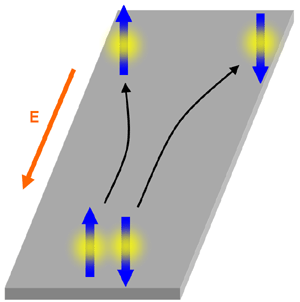Spin Hall Effect
 David Awschalom (courtsey: Awschalom Group, Physics Dept, Univ. of California, Santa Barbara)
David Awschalom (courtsey: Awschalom Group, Physics Dept, Univ. of California, Santa Barbara)The Hall effect, as discovered by Edwin Hall in 1879, refers to the potential difference induced on opposite sides of a thin sheet of conducting or semiconducting material called 'Hall element' when the element is subject to crossed electric and magnetic fields. As a result of this potential diffference, a charge current transverse to both the applied fields appears.
In a research paper published in September 1st issue of Physical Review Letters (full reference below), David Awschalom and colleagues at the Center for Spintronics and Computation at the University of California, Santa Barbara reported the current-induced spin-polarization of electrons and the spin Hall effect in thin surface layers of ZnSe at room temperature.
The spin Hall effect was first observed in GaAs at 20K by Awschalom and Yuichiro Kato in 2004. In an analogy to the conventional Hall effect, the spin Hall effect refers to a pure spin current transverse to an applied electric field in the absence of applied magnetic fields, and was theoretically predicted more than 30 years ago. A pure spin current is a flow of spin angular momentum without any charge current, which can be realized, for example, by spin-up and spin-down electrons moving in opposite directions. At the edges of a sample, the spin current results in accumulation of spins, similar to charge accumulation in the conventional Hall effect.
 The unique advantage of using the spin Hall effect is that it does not require a magnetic field or magnetic materials to generate and separate spins in the solid state. The effect could be of use in the growing field of spintronics, in which the intrinsic spin of the electron (in addition to its electrical charge) is exploited in the development of logic devices. The spin Hall effect could provide a source of spin-polarized electrons for injection into semiconductor devices. Such electrons could carry information based on the state (up or down) of their spin polarization.
The unique advantage of using the spin Hall effect is that it does not require a magnetic field or magnetic materials to generate and separate spins in the solid state. The effect could be of use in the growing field of spintronics, in which the intrinsic spin of the electron (in addition to its electrical charge) is exploited in the development of logic devices. The spin Hall effect could provide a source of spin-polarized electrons for injection into semiconductor devices. Such electrons could carry information based on the state (up or down) of their spin polarization.The spin polarization at 20K was about ten times stronger than at room temperature. Currently, the research team is working to boost the level of spin polarization to levels where nearly all electrons are polarized.
Reference: "Generating Spin Currents in Semiconductors with the Spin Hall Effect", V. Sih, W. H. Lau, R. C. Myers, V. R. Horowitz, A. C. Gossard, and D. D. Awschalom, Phys. Rev. Lett. 97, 096605 (2006).
Study of background materials:
Wikipedia page on 'Hall effect'
Wikipedia page on 'Quantum Hall effect'
"Observation of the spin Hall effect in semiconductors", Y. K. Kato, R. C. Myers, A. C. Gossard, and D. D. Awschalom, Science Express 1105514 (2004)
Labels: Condensed Matter

0 Comments:
Post a Comment